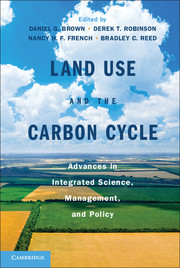Book contents
- Frontmatter
- Contents
- Chapter Authors and Affiliations
- Acknowledgments
- Acronyms
- Part I Introduction
- 1 Linking Land Use and the Carbon Cycle
- 2 An Introduction to Carbon Cycle Science
- 3 The Contribution of Land Use and Land-Use Change to the Carbon Cycle
- 4 An Economic Analysis of the Effect of Land Use on Terrestrial Carbon Storage
- Part II Measurement and Modeling
- Part III Integrated Science and Research Applications
- Part IV Land Policy, Management, and the Carbon Cycle
- Part V Synthesis and Future Directions
- Index
- Plate Section
- References
4 - An Economic Analysis of the Effect of Land Use on Terrestrial Carbon Storage
Published online by Cambridge University Press: 05 February 2013
- Frontmatter
- Contents
- Chapter Authors and Affiliations
- Acknowledgments
- Acronyms
- Part I Introduction
- 1 Linking Land Use and the Carbon Cycle
- 2 An Introduction to Carbon Cycle Science
- 3 The Contribution of Land Use and Land-Use Change to the Carbon Cycle
- 4 An Economic Analysis of the Effect of Land Use on Terrestrial Carbon Storage
- Part II Measurement and Modeling
- Part III Integrated Science and Research Applications
- Part IV Land Policy, Management, and the Carbon Cycle
- Part V Synthesis and Future Directions
- Index
- Plate Section
- References
Summary
Introduction
Markets have altered the global forest landscape to create cropland and pasture. Of the original 5 billion hectares of forest in 1850 (see Chapter 3), the forest has shrunk to 3.6 billion hectares today (Food and Agricultural Organization of the United Nations [FAO] 2010a). A great deal of this conversion was to cropland (Ramunkutty and Foley 1999). At the same time, the forestry sector harvested most of the world's primary forests, replacing it with younger secondary forests (Berck and Bentley 1997). Both of these market activities led to substantial carbon (C) emissions to the atmosphere by reducing the amount of C stored in global primary forests (see Chapter 3).
In addition to these historic activities, several authors claim that market activities continue to lead to substantial C emissions to the atmosphere. The Intergovernmental Panel on Climate Change (IPCC) argues that land use is still responsible for 20 percent of carbon dioxide (CO2) emissions. In the 1990s alone, deforestation contributed 5.8 Gt CO2e (gigaton carbon dioxide equivalent) (IPCC 2007a). The remaining 80 percent of emissions came largely from burning fossil fuels. In addition, agriculture was responsible for methane emissions equal to 3.3 Gt CO2·yr−1 and nitrogen dioxide emissions equal to 2.8 Gt CO2·yr−1 (IPCC 2007b). Although we will not examine these other gases, they do contribute to climate change (IPCC 2007a).
- Type
- Chapter
- Information
- Land Use and the Carbon CycleAdvances in Integrated Science, Management, and Policy, pp. 77 - 92Publisher: Cambridge University PressPrint publication year: 2013



